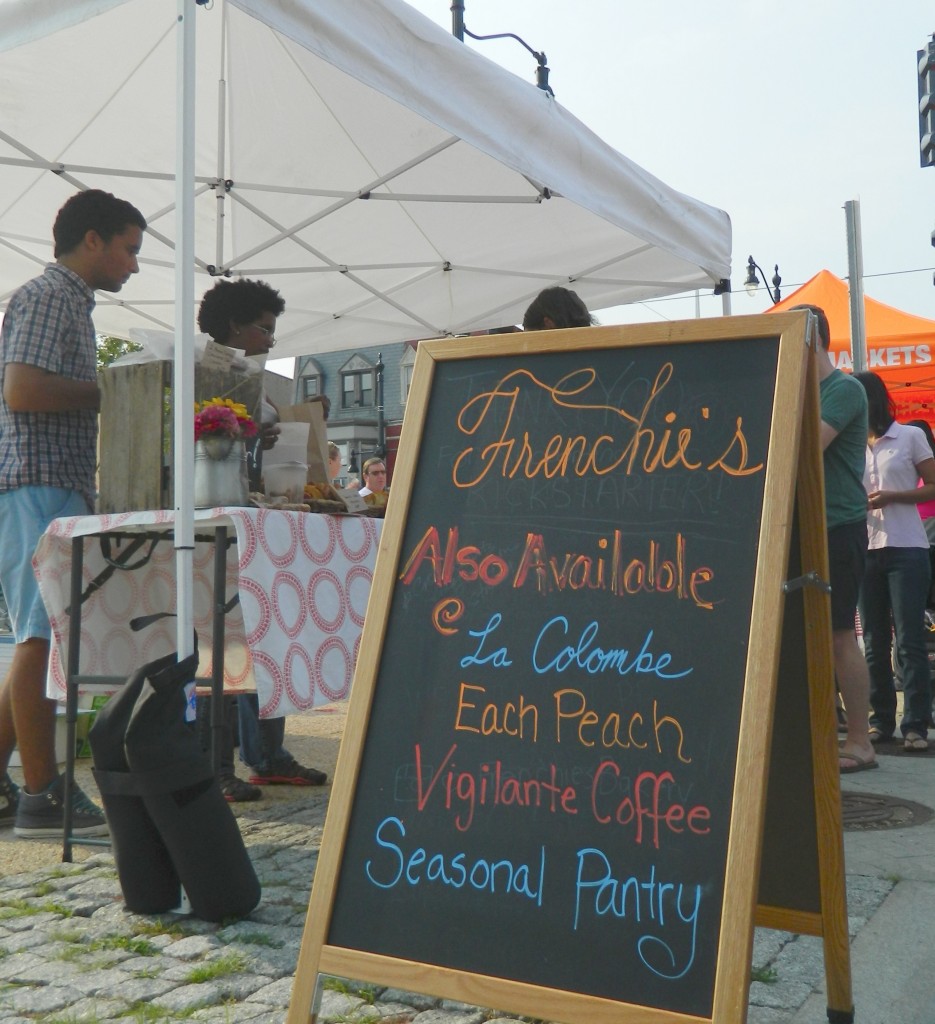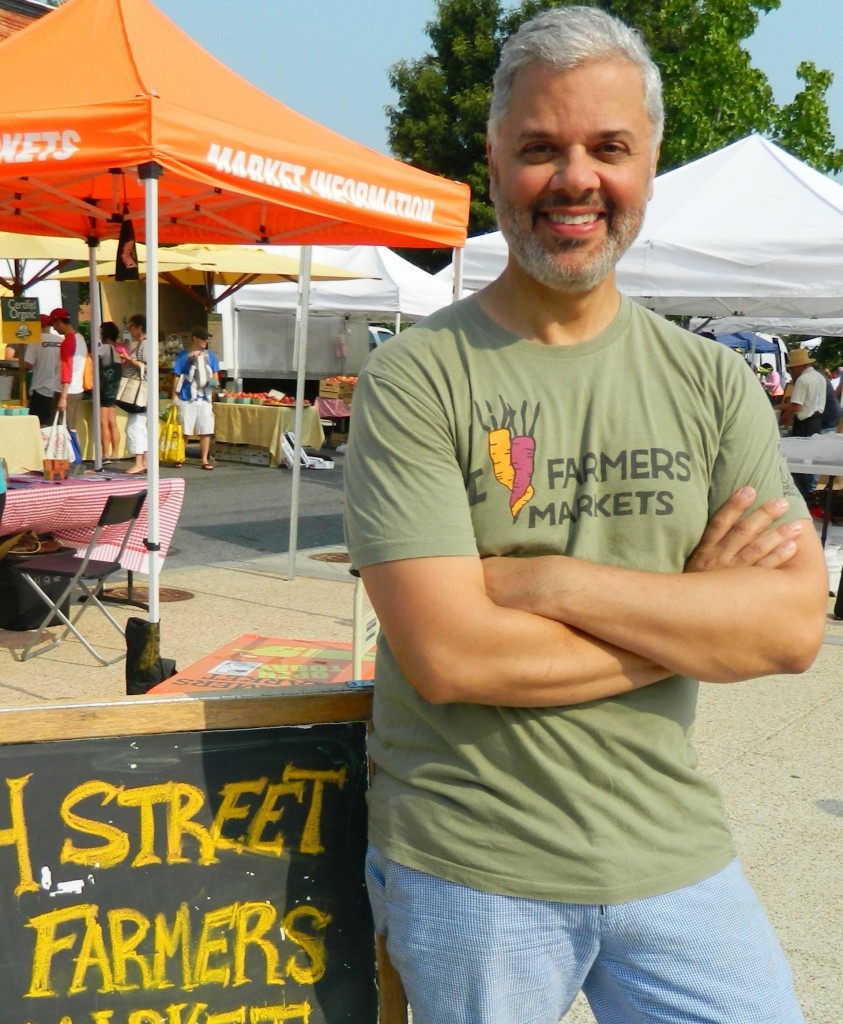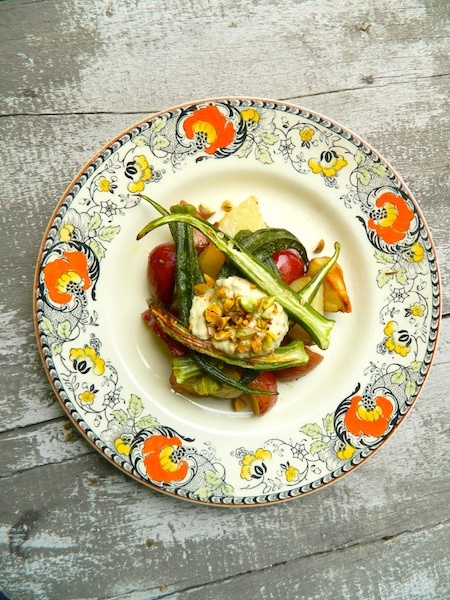What’s in my basket? The Single Cook’s Guide to Farmers Markets
/Shopping with the Washington Post’s Joe Yonan on H Street
Words and photographs by Kristen Hartke
(This article has been nominated for a national EDDY award as "Best Healthful Feature" and needs your vote to help EdibleDC take home the prize! Vote for all THREE of our nominations daily!)
It’s a bright Saturday morning at the H Street FRESHFARM Market in northeast D.C. and Joe Yonan is a man on a mission, making a beeline for the crowd that’s already formed in front of the Frenchie’s Bakery tent.
“They’ll be sold out of everything in an hour,” says Yonan, the Washington Post’s Food and Travel editor, eyeing the cardamom-pistachio morning buns, invitingly dusted in sugar and already disappearing fast even though the market opened just 10 minutes earlier.
Once his basket is filled with fresh baguettes and croissants, Yonan can start considering the fresh produce on offer from local farms, which, thanks to the mid-Atlantic’s long growing season, includes everything from variegated gold and crimson tomatoes and tiny Japanese eggplants to kabocha squash and crisp cauliflower.
“That’s a real advantage about the D.C. area,” he says, “because typical summer produce is available well into the fall, so we can combine a lot of different kinds of fresh ingredients into our meals.”
After spending a year homesteading in Maine, with its short but intense growing season, he’s learned to appreciate our area’s extensive fall bounty, as he sorts through baskets filled with okra, red-skinned potatoes and zucchini in the Indian summer sunshine.
Known for his public transformation from an omnivore to a vegetarian over the past few years, Yonan has also written extensively about cooking for far less than a crowd in his books Serve Yourself: Nightly Adventures in Cooking for One and Eat Your Vegetables: Bold Recipes for the Single Cook, acknowledging that, while it can be challenging to cook for just one—or even two—it still shouldn’t keep anyone from using the freshest ingredients from local farmers.
“Shopping at the farmers market is a good idea for singles,” Yonan notes. “You can buy just a cup of greens here, not a huge pre-packaged bag.”
You’ll also find a greater variety of sizes in the produce, because it’s not all being grown to some uniform dimension: “Smaller sizes of vegetables means it’s just easier to cook in smaller portions.” One idea for the home cook who lives alone: look for a butternut squash that can fit into the palm of your hand, the perfect size to turn into a perfect portion of pasta sauce.
“You can’t go wrong with buying directly from the farmer,” says Yonan. “It’ll stay fresh longer, cook up faster and just taste better.”
In his basket:
Here’s what tickled Joe Yonan’s fancy at the H Street FRESHFARM Market:
Red Russian Kale from Quaker Valley Orchards
Biglerville, Pennsylvania. QuakerValleyOrchards.com
Kale has become pretty trendy over the past few years, Yonan admits, but he loves it anyway. Soak it well in cold water to remove any sand and grit that might be hiding in the leaves.
Feta Cheese from Shepherd’s Whey Creamery
Martinsburg, West Virginia. ShepherdsWheyCreamery.com
It might be fair to say that Yonan is slightly besotted with the cheeses from Shepherd’s Whey Creamery, where they make fresh cheese and yogurt from the milk supplied by their small herd of goats. Their Greek Style Feta is aged for three weeks before it arrives at the market in all its briny goodness.
Carrots, Baby Zucchini and Eggplant from Cedarbrook Farm
Kearneysville, West Virginia. CedarbrookOrganicFarm.com
Carrots grown in spring and fall are particularly sweet, benefiting from warm days and cool nights, so they don’t need much more than a drizzle of honey to bring out their best qualities when cooked. Yonan also looks for tiny Japanese eggplants and baby zucchini just as summer segues into fall to add a fresh earthy note to early autumn dishes.
Cabbage and Okra from Full Cellar Farm
Jefferson, Maryland. FullCellarFarm.com
Yonan loves the variety of sizes of cabbage at the market, especially when shopping for just one or two people, saying “It’s always intimidating to see those huge cabbages the size of pumpkins, but if you look around, there will also be small cabbages in the pile.” As to the okra, which some people fear, Yonan suggests trying his favorite method for cooking them: splitting each one in half lengthwise and then oven-roasting to remove the slime.
Tomatoes and Red-Skinned Potatoes from Richfield Farm
Manchester, Maryland. RealTimeFarms.com/farm/2776004/richfield-farm
Tomatoes are still plentiful in the D.C. region well into fall, so Yonan suggests taking advantage of them as long as they are available. As to the potatoes, he says there is absolutely no comparison between the potatoes you’ll find at the grocery store—which may have been in cold storage for months—and the freshly dug ones available at the farmers market, joking “A fresh potato is so sweet, you can practically eat it raw.”
RECIPE:
Roasted Okra and Potatoes With Feta-Pistachio Cream
Grassy-flavored okra pairs nicely with starchy, creamy potatoes, especially when both are dolloped with a tart, rich, salty purée of feta, pistachios and yogurt in this Middle Eastern treatment. Roasting okra in a hot oven overcomes the slimy quality that some find objectionable (but which most Southerners embrace). Make sure the baking sheets allow for proper air circulation, and preheat them along with the oven, which helps the okra and potatoes caramelize rather than steam.
NOTE: The feta-pistachio cream can be made ahead and refrigerated for up to 1 week; let come to room temperature or microwave for just a few seconds to loosen it before serving.
4 side-dish, appetizer or multi-course servings
1 pound okra (preferably small), trimmed and halved lengthwise
1 pound small red potatoes, scrubbed and quartered
2 tablespoons extra-virgin olive oil
½ teaspoon fine sea salt
2 tablespoons ground sumac (may substitute freshly grated lemon zest)
3 ounces feta, crumbled
cup toasted pistachios, plus 2 tablespoons for garnish (chopped)
2 tablespoons plain Greek-style yogurt
2 tablespoons water, plus more as needed
Preheat oven to 450°, with two large rimmed baking sheets inside. When the sheets are hot, quickly toss the okra pieces onto one sheet and the potatoes onto the other, making sure they don’t overlap. Drizzle each with ½ tablespoon olive oil, ¼ teaspoon salt and 1 tablespoon sumac, and roast until browned on the edges and tender, using a spatula to toss the pieces occasionally: about 15 to 20 minutes for okra and 20 to 25 minutes for the potatoes.
While the vegetables are roasting, make the cream: In the bowl of a food processor, combine the feta, pistachios, yogurt, water and remaining 1 tablespoon olive oil, and purée until smooth, adding a little more water if the mixture is too thick.
When the vegetables are tender, transfer them to a large serving bowl, let cool slightly and toss to combine. Divide among serving plates and dollop each serving with the feta-pistachio cream and some chopped pistachios.
From Joe Yonan, food editor of the Washington Post and author of Eat Your Vegetables: Bold Recipes for the Single Cook (Ten Speed Press, 2014).
Kristen Hartke is managing editor of Edible DC and also writes about creative cocktails at GoodBooze.Wordpress.com. You can follow her @goodbooze on Twitter and Instagram.





